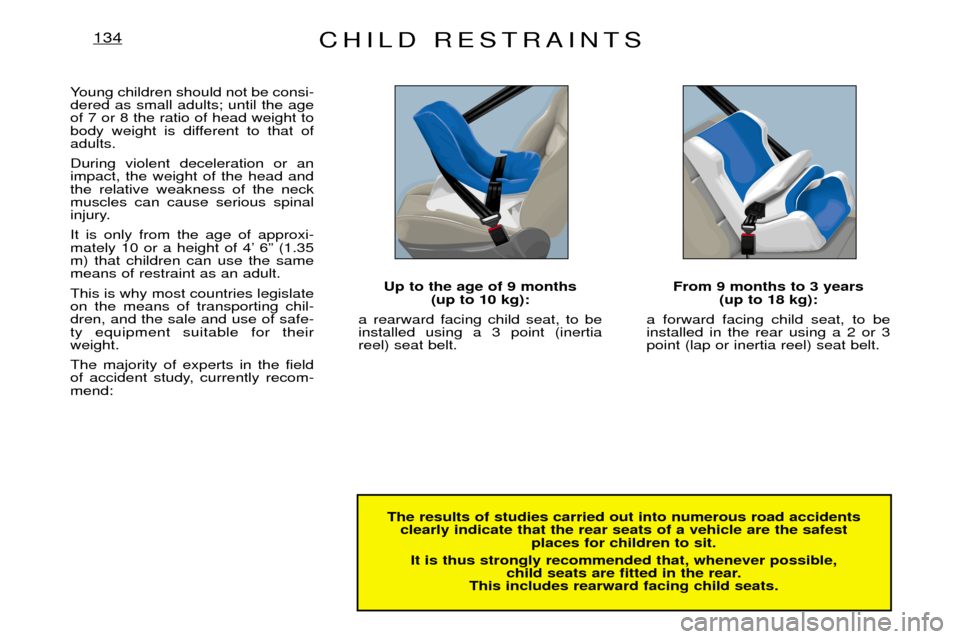Page 12 of 149
FRONT SEATS* (Driver)15I-6Reach Lift the control bar and adjust to the desired position.
Head restraint
To remove, pull upwards.
Armrest
Backrest angle
Turn the handwheel to adjust to the desired position. Driver's seat height
* According to model or country
Page 15 of 149

CHILD RESTRAINTS134
The results of studies carried out into numerous road accidentsclearly indicate that the rear seats of a vehicle are the safest places for children to sit.
It is thus strongly recommended that, whenever possible, child seats are fitted in the rear.
This includes rearward facing child seats.
Young children should not be consi- dered as small adults; until the ageof 7 or 8 the ratio of head weight to
body weight is different to that ofadults. During violent deceleration or an impact, the weight of the head andthe relative weakness of the neckmuscles can cause serious spinal
injury. It is only from the age of approxi-
mately 10 or a height of 4Õ 6Ó (1.35m) that children can use the samemeans of restraint as an adult. This is why most countries legislate on the means of transporting chil-dren, and the sale and use of safe-ty equipment suitable for theirweight. The majority of experts in the field
of accident study, currently recom-mend:
Up to the age of 9 months
(up to 10 kg):
a rearward facing child seat, to beinstalled using a 3 point (inertiareel) seat belt. From 9 months to 3 years
(up to 18 kg):
a forward facing child seat, to beinstalled in the rear using a 2 or 3point (lap or inertia reel) seat belt.
Page 18 of 149
STEERING WHEEL ADJUSTMENTI-817
IMPORTANT
As a safety measure,
these manoeuvres must not be carried out when driving.
The height of the steering wheel can be adjusted.
When stationary, first adjust your seat to the most suitable position.
Unlock the steering wheel by pushing the adjustment control.Adjust the height of the steering wheel then lock it by pulling the adjustment control fully towards you. Make sure that you can see all the displays on the fascia panel.
Page 80 of 149

SEAT BELTS133
- Make all seat belt adjustments when the vehicle is stationary.
- Do not allow the seat belt to rest on any hard or breakable objectsin your pockets.
- Do not use any type of clip or clamp which would prevent the seat belt from tensioning correctly.
- Never use the same seat belt for more than one occupant.
- Never carry a child on your lap.
- Check the seat belts and attachments regularly for cleanliness.
- Have the seat belts checked periodically by your dealer, especially after an accident (even if only minor).
To put on the seat belts: Grip the buckle and withdraw the seat belt smoothly across yourbody making sure that it is not twis-ted. Insert the buckle tongue into itsfixed section of the buckle and pushhome to lock. Pull to check that issecurely located. The lap strap must be positioned as low as possible across the pelvisand should be as tight as possible. The backrest of the seat should be as close to vertical as possible toavoid any risk of slipping beneaththe belt in an impact. SEAT BELTS FRONT The front seats of your vehicle are fitted with height adjustable inertiareel seat belts and pretensionerand grabbing devices.
Two of the three rear seat belts are of the inertia reel type. The wearing of seat belts is obli- gatory for all the occupants ofthe vehicle.
To offer the maximum degree of protection, it is essential that the
seat belt is worn correctly.
Adjusting the height of theupper seat belt anchorage The shoulder strap must be positio- ned across the centre of the shoul-der (see diagram). Never allow theseat belt to run across the neck norunder the arm.
Page 127 of 149
CHANGING A WHEEL107V- 5
Removal1 - If possible, place the car on firm, level ground. Engage the handbrake firmly.
2 - Wait until the vehicle has reached maximum height then switch off the ignition and engage 1st or reverse gear depen-
ding on the incline.
3 - Position the jack at one of the four jacking points on the underside of the vehicle adjacent to the wheels. Using the
wheel brace, extend the jack until it touches the ground.
4 - To remove the embellisher, pull on one of the holes in the embellisher using the end of the wheel brace.
5 - Extend the jack until the wheel is a few centimetres off the ground.
6 - Unscrewing the wheel bolts and remove the wheel.
EE
E
Page 142 of 149
INTERIOR DIMENSIONS*(Model Combi)121VI-3
* According to model or country
Number of seats 5/6 8/9
Boot (m) Useable length - rear door to top of bench-seat 0.98 0.25
Useable length - rear door to base of bench-seat 1.22 0.49
Minimum width between wheel arches 1.19 1.19
Maximum width between wheel arches 1.20 1.20
Height of rear door sill (unladen) 0.58 0.58
Load volume (dm 3
)
To top of backrest 1 164 445
With bench-seat backrest folded 1 590 955
Without bench-seat Ñ 1 325
Total volume to roof (dm 3
) 2 060 600
With bench-seat backrest folded 3 380 1 870
With third row bench-seat removed Ñ 2 250